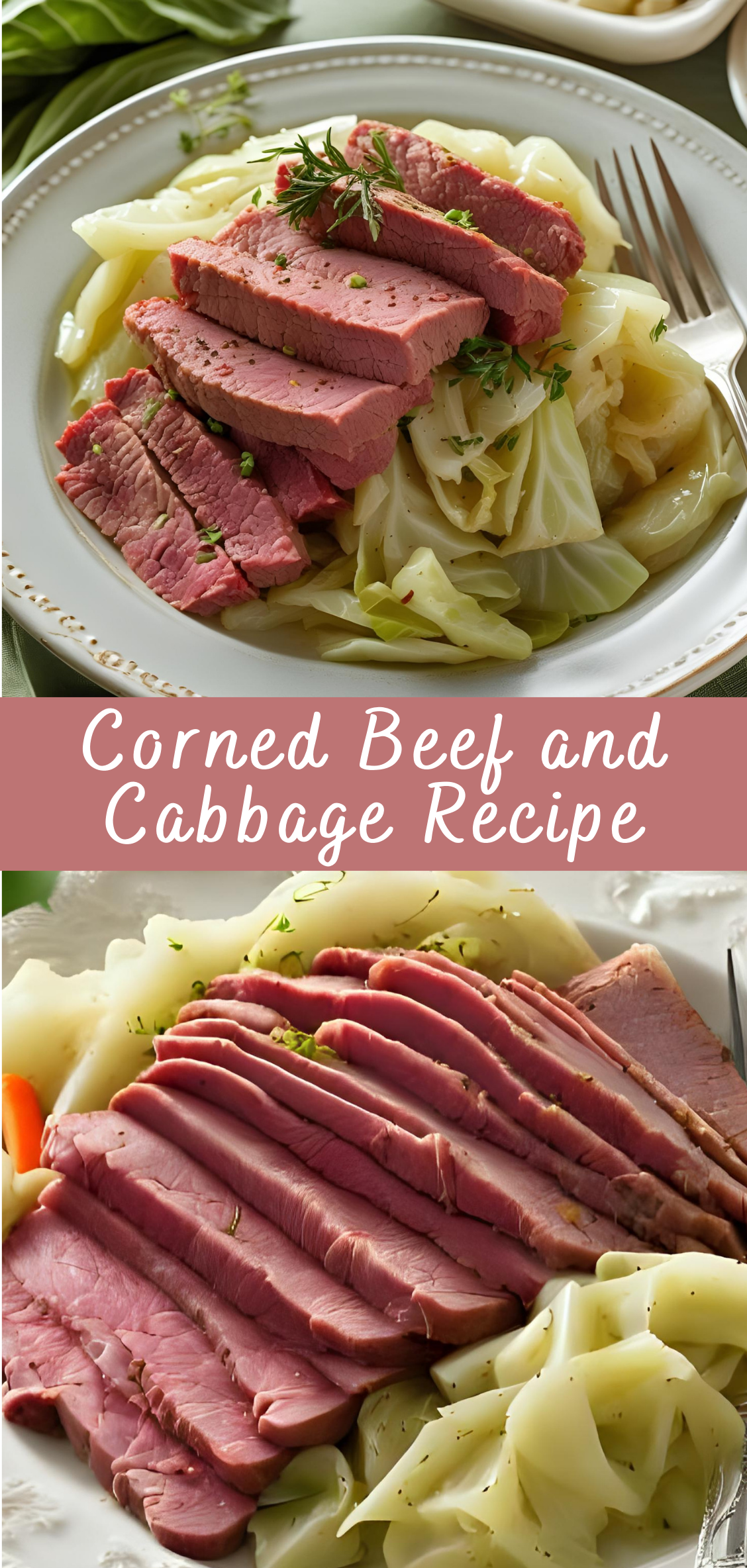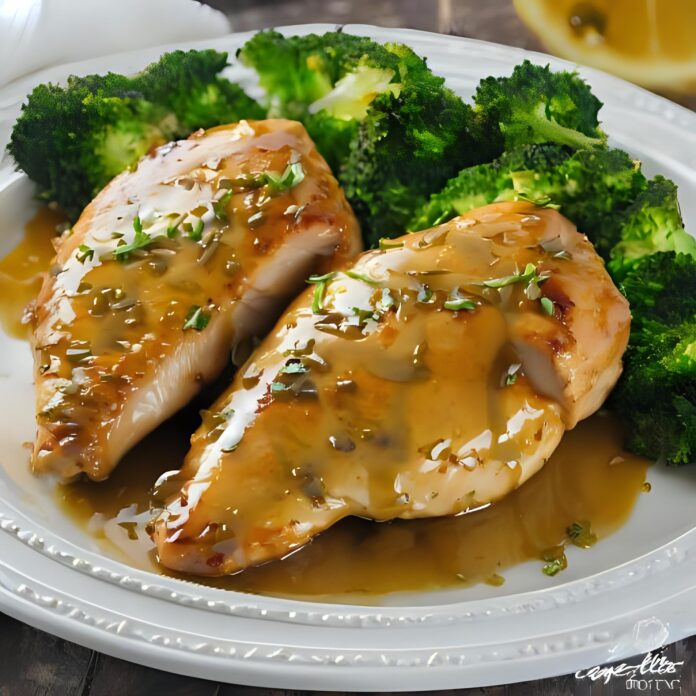Corned Beef and Cabbage Recipe
Few dishes evoke such a strong sense of cultural identity and nostalgia as Corned Beef and Cabbage. Hearty, humble, and deeply comforting, this beloved meal is more than just a St. Patrick’s Day staple—it’s a time-honored tradition that bridges history, heritage, and home cooking.

Corned beef and cabbage is most commonly associated with Irish-American cuisine, but its story is far more complex and layered than it may seem. It’s a dish born not in Ireland itself, but in the immigrant neighborhoods of New York and Boston, where Irish newcomers adapted their traditional meals to the ingredients and economic realities of a new world. Over time, it became a signature meal for generations of Irish-Americans and, more broadly, a symbol of celebration, family, and shared meals.
At its core, corned beef and cabbage is a simple dish built from resourceful ingredients. The star is a cut of beef—typically brisket—that has been cured in a seasoned brine. The term “corned” comes not from corn the vegetable, but from the coarse “corns” of salt historically used in the preservation process. When simmered slowly with aromatic spices and vegetables like carrots, potatoes, and cabbage, the result is a meal that’s tender, flavorful, and soul-warming.
Despite its simplicity, making a perfect corned beef and cabbage dish requires a balance of time, temperature, and technique. It’s a slow-cooked labor of love—one that rewards patience with rich flavor and melt-in-your-mouth texture. Whether you’re preparing it for a holiday meal, Sunday dinner, or simply to connect with culinary tradition, corned beef and cabbage is a dish that offers more than just nourishment. It offers a link to the past and a ritual of comfort that brings people together around the table.
This comprehensive guide explores corned beef and cabbage in all its dimensions—from its origins and cultural journey, to the science behind brining, to modern methods of cooking that include stovetop, oven, slow cooker, and pressure cooker variations. We’ll also explore ingredient selection, including tips for choosing the right cut of meat, understanding the pickling spices, and preparing vegetables for optimal texture and flavor. You’ll find detailed step-by-step instructions, timing guides, and expert tips to avoid common pitfalls.
But we won’t stop there. This article will also dive into recipe variations (including low-sodium, keto, and gluten-free adaptations), regional and international takes on corned beef, and what to do with leftovers—from sandwiches to hash and beyond. We’ll even share guidance on beer and beverage pairings, side dish suggestions, and presentation tips to make your corned beef and cabbage not just a meal, but a memorable dining experience.
Whether you’re a seasoned home cook looking to perfect your technique or a curious first-timer drawn to the dish’s cultural and culinary roots, this article will equip you with everything you need. By the end, you’ll not only know how to make an incredible corned beef and cabbage dinner—you’ll also understand why it continues to endure as a symbol of tradition, resilience, and hospitality.
Let’s begin by exploring the history and cultural evolution of corned beef and cabbage—tracing its journey from the countryside of Ireland to the streets of America, and into the kitchens of millions around the world.
How to Make Corned Beef and Cabbage – Step-by-Step Instructions
What Is Corned Beef?
Before we start cooking, let’s clarify what we’re working with.
Corned beef is typically made from brisket, a tough cut of beef from the chest area of the cow. The meat is cured in a salty, seasoned brine—often for several days—which not only preserves the meat but infuses it with bold flavor. The term corned refers to the coarse “corns” or grains of salt traditionally used in the brining process.
You can find pre-brined corned beef in most grocery stores around St. Patrick’s Day (and year-round in some places). It usually comes vacuum-packed with or without a spice packet.
Ingredients
For the Main Dish:
-
3–4 lb corned beef brisket, with seasoning packet
-
10–12 cups cold water
-
1 medium yellow onion, peeled and quartered
-
3–4 cloves garlic, smashed
-
2 bay leaves
-
1 tsp whole black peppercorns
-
1 tsp mustard seeds (optional)
-
1 tsp coriander seeds (optional)
Most pre-packaged corned beef briskets come with a spice packet. If yours doesn’t, use the spices listed above.
For the Vegetables:
-
1 small head green cabbage, cut into wedges
-
6–8 medium carrots, peeled and cut into 2–3-inch pieces
-
6 medium Yukon Gold or red potatoes, halved or quartered
-
2 ribs celery, cut into large chunks (optional)
-
Salt and pepper, to taste
-
2–3 tbsp butter (for serving, optional)
-
Fresh parsley, chopped (for garnish)
Equipment You’ll Need
-
Large stock pot or Dutch oven (at least 6–8 qt capacity)
-
Cutting board and sharp knife
-
Slotted spoon or tongs
-
Ladle
-
Large serving platter or bowl
Alternative cooking methods like slow cooker, oven-braised, and pressure cooker (Instant Pot) instructions will be covered in a later section.
Step-by-Step Cooking Instructions (Stovetop Method)
Step 1: Rinse the Corned Beef
Remove the corned beef from its packaging. Rinse it under cold water to remove excess brine and surface salt. Pat it dry with paper towels.
Note: Don’t skip rinsing, or your broth will be overly salty.
Step 2: Place in Pot and Add Aromatics
Place the brisket in the bottom of a large pot or Dutch oven, fat side up.
Add:
-
Spice packet (or homemade pickling spices)
-
Quartered onion
-
Smashed garlic
-
Bay leaves
-
Peppercorns
-
Mustard and coriander seeds (if using)
Pour in enough cold water to cover the brisket by about 1–2 inches (10–12 cups depending on your pot).
Step 3: Bring to a Simmer
Place the pot on the stove over medium-high heat. Bring it just to a boil—watch carefully to avoid boiling too hard, which can toughen the meat.
As soon as bubbles form and foam rises to the top, reduce the heat to low and skim off any foam or scum using a spoon or ladle.
Step 4: Simmer Low and Slow (2.5 to 3.5 Hours)
Cover the pot loosely with a lid and let it simmer gently—not boil—for about 2.5 to 3.5 hours, or until the meat is fork-tender.
Timing tip: Cook 45–60 minutes per pound. A 3-lb brisket will take about 2.5–3 hours; a 4-lb brisket may take closer to 3.5 hours.
Check the meat occasionally and skim fat if needed. Do not let it boil—keep it at a low, steady simmer.
Step 5: Add the Vegetables (Last 30–40 Minutes)
Once the beef is tender, remove it from the pot using tongs or a slotted spoon. Set it on a cutting board and cover loosely with foil to rest.
Now, add the vegetables directly into the flavorful broth:
-
Potatoes and carrots first (they take longer)
-
After 15 minutes, add the cabbage and celery
Simmer everything until tender but not mushy, about 25–30 minutes total.
Tip: Don’t overcook the cabbage—it should be soft but still retain some shape and texture.
Step 6: Slice the Corned Beef
After resting for 10–15 minutes, slice the corned beef against the grain into ¼-inch slices.
Cutting against the grain ensures tenderness. Look for the direction of the muscle fibers and slice perpendicular to them.
Step 7: Serve and Garnish
Arrange the sliced beef on a platter surrounded by cabbage, potatoes, and carrots.
-
Drizzle melted butter over the vegetables for extra richness
-
Garnish with chopped fresh parsley
-
Serve with Dijon mustard, whole grain mustard, or horseradish on the side
Optional: Ladle a bit of hot cooking broth over the meat and veggies just before serving to keep everything moist and flavorful.
Serving Suggestions
Corned beef and cabbage is a complete meal, but here are some great additions:
-
Irish soda bread or buttermilk biscuits
-
Grainy mustard, horseradish sauce, or apple cider vinegar for brightness
-
Pickled beets, onions, or a simple green salad on the side
Corned Beef and Cabbage Recipe
Few dishes evoke such a strong sense of cultural identity and nostalgia as Corned Beef and Cabbage. Hearty, humble, and deeply comforting, this beloved meal is more than just a St. Patrick’s Day staple—it’s a time-honored tradition that bridges history, heritage, and home cooking.
Ingredients
- 3–4 lb corned beef brisket, with spice packet
- 10 cups water (or enough to cover the beef)
- 1 large onion, quartered
- 3–4 garlic cloves, smashed
- 1 bay leaf (optional, if not in spice packet)
- 1 lb carrots, peeled and cut into large chunks
- 1.5 lbs Yukon gold or red potatoes, halved or quartered
- 1 small head green cabbage, cut into wedges
- Salt & black pepper to taste
- Optional: 1 tbsp whole grain mustard or Dijon (for flavoring broth or serving)
Instructions
- Rinse the beef under cold water to remove excess brine. Place in a large stockpot.
- Add aromatics:
Cover with water and add the spice packet, onion, garlic, and bay leaf. - Bring to a boil, then reduce heat to low. Cover and simmer gently for about 2.5 to 3 hours, or until beef is fork-tender.
- Add vegetables:
Add potatoes and carrots; simmer for 10 minutes. Then add cabbage wedges and simmer everything together for another 15–20 minutes, or until veggies are tender. - Rest and slice:
Remove beef and let it rest for 10 minutes before slicing against the grain. - Serve:
Arrange sliced beef on a platter with vegetables. Spoon broth over the top if desired.
Notes
- Slow Cooker Version:
Cook everything (except cabbage) on low for 8–9 hours or high for 4–5 hours. Add cabbage for the last 1.5 hours on low or 1 hour on high. - Instant Pot Version:
Cook corned beef with onion, garlic, spice packet, and 4 cups water on High Pressure for 90 minutes. Natural release 15 minutes. Add veggies and cook under pressure for 5 minutes more. - Flavor tip: Add a bottle of beer (like Guinness or lager) to the cooking liquid for extra richness.
- Leftovers idea: Make corned beef hash or sandwiches with rye bread, Swiss cheese, and sauerkraut!



